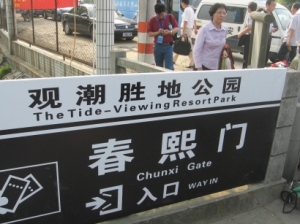One of our scientists, Clark Alexander, just returned from two weeks in China, where he attended the 7th International Conference in Tidal Sedimentation in Qingdao, China.

A Chinese coastal vessel is intentionally grounded at low tide so the crew can search the mud for shellfish. Come high tide, it floats again.
Prior to the meeting, he took part in a 5-day field trip which covered 1,500 kilometers along the west coast of the Yellow Sea, from Shanghai to Qingdao, where he was excited to observe one of the best tidal bores and some of the muddiest and most extensive tidal flats in the world.
Alexander is a member of the International Scientific Steering Committee for this quadrennial series of meetings, and he gave a keynote presentation on the hammock stratigraphic work being carried out by his lab group.



